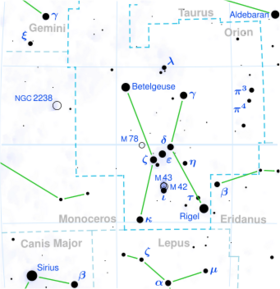Astronomy:HD 40657
| Observation data Equinox J2000.0]] (ICRS) | |
|---|---|
| Constellation | Orion |
| Right ascension | 06h 00m 03.34979s[1] |
| Declination | −3° 04′ 27.3341″[1] |
| Apparent magnitude (V) | 4.52[2] |
| Characteristics | |
| Spectral type | K1.5III-IIIb CN-1[3] |
| U−B color index | +1.21[2] |
| B−V color index | +1.22[2] |
| Variable type | suspected[4] |
| Astrometry | |
| Radial velocity (Rv) | +25.9±0.9[5] km/s |
| Proper motion (μ) | RA: +10.646[1] mas/yr Dec.: −73.589[1] mas/yr |
| Parallax (π) | 11.2968 ± 0.2633[1] mas |
| Distance | 289 ± 7 ly (89 ± 2 pc) |
| Absolute magnitude (MV) | −1.00[6] |
| Details | |
| Mass | 1.68[7] M☉ |
| Radius | 25.06+0.84 −0.51[1] R☉ |
| Luminosity | 196.4±5.2[1] L☉ |
| Surface gravity (log g) | 2.42[8] cgs |
| Temperature | 4,317+53 −80[1] K |
| Metallicity [Fe/H] | −0.48[6] dex |
| Rotational velocity (v sin i) | 2.1[9] km/s |
| Age | 2.27[7] Gyr |
| Other designations | |
| Database references | |
| SIMBAD | data |
HD 40657 is a single[11] star in the equatorial constellation of Orion, near the constellation border with Monoceros. It has an orange hue and is faintly visible to the naked eye with an apparent visual magnitude of 4.52.[2] The star is located at a distance of approximately 289 light years from the Sun based on parallax.[1] It is drifting further away with a radial velocity of +26 km/s.[5]
This is an aging giant star with a stellar classification of K1.5III-IIIb CN-1,[3] where the suffix notation indicates an underabundance of cyanogen in the spectrum. Having exhausted the supply of hydrogen at its core, this star cooled and expanded off the main sequence. At present it has 25 times the radius of the Sun.[1]
HD 40657 is a suspected variable star with a brightness that has been measured ranging from magnitude 4.54 down to 4.58.[4] It is an estimated 2.27[7] billion years old with 1.68[7] times the mass of the Sun and is spinning with a projected rotational velocity of 2.1 km/s.[9] The star is radiating 196 times the Sun's luminosity from its swollen photosphere at an effective temperature of 4,317 K.[1]
References
- ↑ 1.00 1.01 1.02 1.03 1.04 1.05 1.06 1.07 1.08 1.09 1.10 Brown, A. G. A. (August 2018). "Gaia Data Release 2: Summary of the contents and survey properties". Astronomy & Astrophysics 616: A1. doi:10.1051/0004-6361/201833051. Bibcode: 2018A&A...616A...1G. Gaia DR2 record for this source at VizieR.
- ↑ 2.0 2.1 2.2 2.3 Ducati, J. R. (2002). "VizieR Online Data Catalog: Catalogue of Stellar Photometry in Johnson's 11-color system". CDS/ADC Collection of Electronic Catalogues 2237. Bibcode: 2002yCat.2237....0D.
- ↑ 3.0 3.1 Keenan, Philip C.; McNeil, Raymond C. (1989). "The Perkins catalog of revised MK types for the cooler stars". The Astrophysical Journal Supplement Series 71: 245. doi:10.1086/191373. Bibcode: 1989ApJS...71..245K.
- ↑ 4.0 4.1 Samus, N. N. et al. (2017). "General Catalogue of Variable Stars". Astronomy Reports. 5.1 61 (1): 80–88. doi:10.1134/S1063772917010085. Bibcode: 2017ARep...61...80S.
- ↑ 5.0 5.1 Wilson, R. E. (1953). "General Catalogue of Stellar Radial Velocities". Carnegie Institute Washington D.C. Publication (Carnegie Institution for Science). Bibcode: 1953GCRV..C......0W.
- ↑ 6.0 6.1 Anderson, E.; Francis, Ch. (2012). "XHIP: An extended hipparcos compilation". Astronomy Letters 38 (5): 331. doi:10.1134/S1063773712050015. Bibcode: 2012AstL...38..331A. Vizier catalog entry
- ↑ 7.0 7.1 7.2 7.3 Luck, R. Earle (2015). "Abundances in the Local Region. I. G and K Giants". Astronomical Journal 150 (3): 88. doi:10.1088/0004-6256/150/3/88. Bibcode: 2015AJ....150...88L.
- ↑ Soubiran, Caroline; Le Campion, Jean-François; Brouillet, Nathalie; Chemin, Laurent (2016). "The PASTEL catalogue: 2016 version". Astronomy & Astrophysics 591: A118. doi:10.1051/0004-6361/201628497. Bibcode: 2016A&A...591A.118S.
- ↑ 9.0 9.1 De Medeiros, J. R.; Alves, S.; Udry, S.; Andersen, J.; Nordström, B.; Mayor, M. (2014). "A catalog of rotational and radial velocities for evolved stars". Astronomy & Astrophysics 561: A126. doi:10.1051/0004-6361/201220762. Bibcode: 2014A&A...561A.126D. Vizier catalog entry
- ↑ "HD 40657". SIMBAD. Centre de données astronomiques de Strasbourg. http://simbad.u-strasbg.fr/simbad/sim-basic?Ident=HD+40657.
- ↑ Eggleton, P. P.; Tokovinin, A. A. (September 2008). "A catalogue of multiplicity among bright stellar systems". Monthly Notices of the Royal Astronomical Society 389 (2): 869–879. doi:10.1111/j.1365-2966.2008.13596.x. Bibcode: 2008MNRAS.389..869E.
 |


